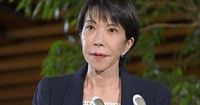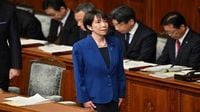Japan's political stage has seen a dramatic shift this week as Sanae Takaichi, the country's newly appointed prime minister, steps into the international spotlight with a slate of high-stakes diplomatic challenges. Barely days into her tenure—she took office on Tuesday, October 21, 2025—Takaichi faces a packed diplomatic schedule that will test her resolve, political instincts, and ability to walk the tightrope between powerful, and sometimes unpredictable, international partners.
Her first days in office are anything but quiet. According to the Associated Press, Takaichi’s initial foray into world affairs includes a whirlwind of summits and state visits: meetings with Southeast Asian leaders in Malaysia, a high-profile encounter with U.S. President Donald Trump in Tokyo, and a crucial Asia-Pacific Economic Cooperation (APEC) summit in South Korea. The diplomatic gauntlet, as some analysts have called it, is a trial by fire for a leader whose international experience is limited and whose domestic coalition remains fragile.
At her first news conference as prime minister, Takaichi described her schedule as “packed” with diplomatic events, emphasizing the value of engaging with regional leaders. She told reporters, “It will be a valuable opportunity to meet other regional leaders.” Her agenda underscores the urgency Japan faces in maintaining its influence and stability in a region marked by shifting alliances and simmering tensions.
Yet even before her first overseas trip, the tone of her reception abroad has been telling. Unlike her predecessor, Shigeru Ishiba—who held more moderate positions on China and was quickly congratulated by Chinese leaders—Takaichi has received no public congratulations from either Chinese President Xi Jinping or Premier Li Qiang since her appointment. This diplomatic chill, reported by The Associated Press, signals China's wariness of Takaichi’s hawkish stance on military policy and her unapologetic views on Japan’s wartime history.
Takaichi’s itinerary began with her arrival in Malaysia on Saturday, October 25, 2025, for talks with Southeast Asian leaders. She is set to return to Japan for a critical meeting with President Trump before heading to South Korea for the APEC summit at the end of the week. Xi Jinping is also expected at the South Korea summit, where he will meet with Trump. However, a one-on-one meeting between Xi and Takaichi is considered highly unlikely, though some experts say a brief courtesy greeting could occur.
For Takaichi, the U.S.-Japan alliance remains central. In a policy speech to parliament, she described the partnership as the “cornerstone” of Japan’s diplomacy and security policy. “Japan, from the U.S. perspective, is an indispensable partner for America’s China strategy or its Indo-Pacific strategy,” she said at her news conference, as cited by AP.
But the alliance faces new strains. Trump, who has repeatedly demanded that U.S. allies shoulder more of their own defense costs, is expected to press Takaichi for greater financial and strategic commitments. He has also imposed tariffs on Japanese imports, delivering a blow to Japan’s economy. During his visits to both Japan and South Korea, Trump is likely to focus on securing more Japanese investment in U.S. manufacturing—especially factories that would create jobs for American workers, according to AP and Sydney Morning Herald.
In response, Takaichi announced on Friday, October 24, 2025, that Japan would accelerate its plan to boost defense spending to 2% of GDP—a goal now set for March 2026, a year ahead of schedule. “In the region around Japan, military activities and other actions from our neighbors China, North Korea and Russia are causing grave concerns,” she told parliament. Her pledge is widely seen as an attempt to both satisfy U.S. demands and address escalating regional threats.
Yet this move is not without risk. China, North Korea, and Russia have all expressed alarm over Japan’s increasing military posture. Chinese experts, quoted in AP, warn that Takaichi’s push for a military build-up and her right-wing views on Japan’s wartime actions could spark intensified military confrontation and reignite disputes over historical grievances. Shi Yinhong, a professor at Beijing’s Renmin University, predicts that “the military confrontation between Japan and China will intensify under Takaichi, and disputes over wartime history could increase.”
Complicating matters further is Takaichi’s political lineage. She is a protégé of former Prime Minister Shinzo Abe, whose tenure was marked by a delicate balancing act: deepening military ties with the U.S. while maintaining a working relationship with China. Takaichi shares Abe’s conservative views on Japan’s wartime history—perhaps even more strongly. Before becoming prime minister, she was among the lawmakers who regularly visited Yasukuni Shrine, a memorial that honors Japan’s war dead, including convicted war criminals. These visits have long angered both China and South Korea.
However, in a calculated move, Takaichi notably skipped a visit to the shrine during the autumn festival earlier this month, when it appeared likely she would assume the premiership. Experts believe this was no accident. Gerald Curtis, a Japanese politics expert at Columbia University, told AP, “It would be so foolish of her especially in her first year to create a major diplomatic incident because she wants to go to Yasukuni Shrine.” He added that her right-wing supporters already know she is on their side, so she does not need to visit the shrine to prove her loyalties.
Chinese scholars echo this sentiment. Lian Degui of Shanghai International Studies University noted that Abe rarely visited Yasukuni Shrine as prime minister, which helped prevent a complete breakdown in relations with China. “If she can learn from Abe, bilateral relations will not deteriorate,” Lian said. “Abe rarely visited Yasukuni Shrine as prime minister and this is the foundation for bilateral relations.”
Despite these efforts at moderation, few expect a thaw in Sino-Japanese relations anytime soon. Rintaro Nishimura, a senior associate at The Asia Group, told AP that China is now more focused on dealing directly with Trump than with Japan. “Given the situation now, their focus is on dealing with Trump directly, and Japan I don’t think is their first priority at this point,” he observed. Liu Jiangyong, an East Asian studies specialist at Tsinghua University, cautioned that Takaichi’s statements about maintaining stable ties with China are “all the pre-established tones of the Japanese foreign ministry.”
For Takaichi, the immediate priority is political stability at home. Her coalition government is still weak and untested, and any diplomatic misstep—particularly over historical issues—could quickly erode her support. Experts widely agree that she will avoid expressing controversial views on wartime history or visiting Yasukuni Shrine, at least in her first year.
As the week unfolds, all eyes will be on Takaichi’s performance on the world stage. Will she manage to strengthen Japan’s alliances, keep regional tensions in check, and maintain political stability at home? The coming days may well define her leadership—and shape Japan’s role in an increasingly turbulent Asia.



